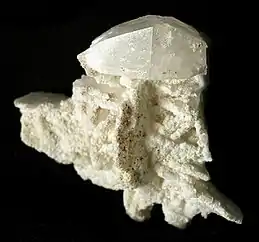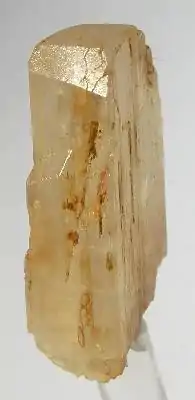| Hambergite | |
|---|---|
 2.3 × 1.1 × 1 cm crystal of hambergite on albite from Paprok, Nuristan Province, Afghanistan | |
| General | |
| Category | Borate mineral |
| Formula (repeating unit) | Be2BO3OH |
| IMA symbol | Hb[1] |
| Strunz classification | 6.AB.05 |
| Crystal system | Orthorhombic |
| Crystal class | Dipyramidal (mmm) H-M symbol: (2/m 2/m 2/m) |
| Space group | Pbca |
| Unit cell | a = 9.76, b = 12.20 c = 4.43 [Å]; Z = 8 |
| Identification | |
| Color | Colorless, pale gray, pale yellow |
| Crystal habit | Prismatic crystals |
| Twinning | On {110} |
| Cleavage | Perfect on {010}, good on {100} |
| Tenacity | Brittle |
| Mohs scale hardness | 7.5 |
| Luster | Vitreous |
| Streak | White |
| Diaphaneity | Transparent to translucent |
| Specific gravity | 2.347–2.372 |
| Optical properties | Biaxial (+) |
| Refractive index | nα = 1.554 – 1.560 nβ = 1.587 – 1.591 nγ = 1.628 – 1.631 |
| Birefringence | δ = 0.074 |
| Pleochroism | Colorless |
| 2V angle | 87° |
| Solubility | Soluble in HF (Hydrogen fluoride) |
| References | [2][3][4] |
Hambergite (Be2BO3OH) is a beryllium borate mineral named after Swedish explorer and mineralogist Axel Hamberg (1863–1933). The mineral occurs as white or colorless orthorhombic crystals.[3][4][2]

Tabular, terminated crystal from the Gem Hill, Mesa Grande District, San Diego County, California (size: 1.5 × .8 × .5 cm)
Occurrence
Hambergite occurs in beryllium bearing granite pegmatites as a rare accessory phase. It occurs associated with beryl, danburite, apatite, spodumene, zircon, fluorite, feldspar and quartz.[2]
It was first described by mineralogist and geographer W. C. Brøgger in 1890.[5] The type locality is Salbutangen, Helgeroa, Langesundsfjorden, Larvik, Vestfold, Norway where it was found in a pegmatite dike of nepheline syenite composition.[3][6]
References
- ↑ Warr, L.N. (2021). "IMA–CNMNC approved mineral symbols". Mineralogical Magazine. 85 (3): 291–320. Bibcode:2021MinM...85..291W. doi:10.1180/mgm.2021.43. S2CID 235729616.
- 1 2 3 "Hambergite" (PDF). Mineral Data Publishing. Retrieved 6 January 2012.
- 1 2 3 "Hambergite". mindat.org. Retrieved 6 January 2012.
- 1 2 "Hambergite Mineral Data". Retrieved 6 January 2012.
- ↑ Godal, Anne Marit (ed.). "hambergitt". Store norske leksikon (in Norwegian). Norsk nettleksikon. Retrieved 6 January 2012.
- ↑ Mindat location data
Bibliography
- Palache, P.; Berman H.; Frondel, C. (1960). "Dana's System of Mineralogy, Volume II: Halides, Nitrates, Borates, Carbonates, Sulfates, Phosphates, Arsenates, Tungstates, Molybdates, Etc. (Seventh Edition)" John Wiley and Sons, Inc., New York, pp. 370–372.
- G. Diego Gatta; Garry J. McIntyre; Geoffrey Bromiley; Alessandro Guastoni; Fabrizio Nestola American Mineralogist (2012) 97 (11–12): 1891–1897. https://doi.org/10.2138/am.2012.4232
This article is issued from Wikipedia. The text is licensed under Creative Commons - Attribution - Sharealike. Additional terms may apply for the media files.